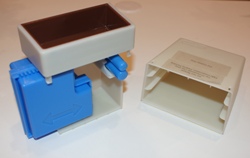As last year, bed bugs remain the number one pest demanding attention from the US pest management industry. If anything, the situation is worsening. But with problems come opportunities. Opportunities to develop new techniques and new products. Also opportunities for further scientific research, in a bid to understand this pest all the more. Both these aspects received considerable attention at this years event.
Nothing new!
As part of the special Bed Bug Forum, Dr Michael Potter from the University of Kentucky set the ball rolling with an excellent presentation charting the rise of bed bugs as a problem pest since man first lived in caves.
|
Leaping forward several thousands of years, fossil bed bugs were found some 3,500 years ago in Egyptian cities. It was from the Middle East that they dispersed, mainly accompanying the traders of the day, arriving in Europe (Italy) in 100 AD, 1000 in Germany and France and around 1,500 in England. They were not known in the USA until the 1600”s when brought by the first settlers. But it wasn’t until the growth of the industrial towns and the building of the railroads that they really became a wide-scale pest. In 1944, for example, Sameth Exterminating in New York was recording 120 calls a day for bed bug treatments! The theme throughout Mike’s talk was “there is nothing new with bed bugs.” Just as they expanded east at the turn of the century, the very same thing has happened this time around. From the first reports in the 1990”s in the eastern US gateway towns, they have consistently moved westward. He quoted the most recent 2011 NPMA Bugs Without Borders Survey (click here to view) which showed that 99% of all respondents had encountered bed bug infestations in the last year – up from 71% in urban and 80% in suburban areas in the 2010 survey – see Pest report here. The report also showed that increasingly bed bugs are becoming bugs without beds – as their prevalence outside the home has risen, for example in schools, modes of transport, office buildings etc. Likewise there is nothing new in the design of beds. The sophisticated ‘designer’ beds of today which offer a myriad of hard to detect and impossible to treat hiding places, are not far-off the classic four-poster beds of the Middle Ages. In following sessions, Kevin Sweeney from the US Environmental Protection Agency (EPA), Washington queried the efficacy claims presented on product labels and called for the creation of a standard for bed bug experimental design. Somewhat frustratedly he asked: “We need to agree when a dead bed bug can be rated as ‘dead’.” He posed the questions: is lab and field testing equivalent? What method do we have to determine resistance? EPA is currently addressing these issues with an outcome due in 2012. Steve Dwinnel from the Florida Department of Agriculture and Consumer Services expressed concern that label statements need reviewing – are consumers buying DIY products getting what they think they are getting? This was a theme taken up by Susan Jones, Associate Professor of Entomology from Ohio State University. In her work she had evaluated the efficacy of DIY indoor foggers – from her results the only lethal effect these cans were likely to deliver were ‘kills on contact’ – meaning when you smashed the bed bug with the can! From the presentation given by Dr Stephen Kells, University of Minnesota, which addressed bed bug feeding regimes, movement, aggregation behaviour, pheromones and kairomones (what humans produce that attract bed bugs) it becomes clear how much further research work is required to fully understand this ubiquitous pest. New bed bug monitor from FMC Having taken over two years to develop, this detector employs both pheromones and kairomones. First, a replaceable C02 booster pack mimics a living breathing host for up to 24 hours – so providing an initial population assessment. A replaceable lure containing pheromone and kairomone then continually emit their odours for up to 90 days to attract both host-seeking and aggregation-seeking bed bugs. There is both a pitfall trap which the bed bugs are unable to climb out off, as well a harbourage area on the back of the detector, designed to encourage bed bugs to gather. Certainly an impressive piece of kit. But FMC was keeping tight-lipped as to its price. And if for introduction elsewhere in the world, regulatory issues may emerge concerning the pheromones used. Elsewhere in the exhibition there was an amazing array of exhibitors selling heat delivery systems. As too there was for booths promoting and displaying all means of mattress protection devices. |
|
|
|
|
||









